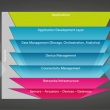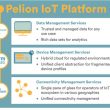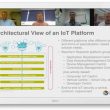

The first person I ran into at last week’s IoT Solutions World Congress 2018 in Barcelona was an old friend of IoT Now’s who shall remain nameless. He looked exhausted. I had arrived a few hours after him on the first day. (more…)
October 26, 2018
Posted by: Anasia D'mello

New research points to improved network security, connectivity, flexibility, and cost savings coming from SD-WAN services.
October 25, 2018
Posted by: Anasia D'mello

ForeScout Technologies, Inc., an Internet of Things (IoT) security company, has teamed up with Belden, a global provider of industrial networking and cybersecurity systems, to help organisations mitigate detrimental impacts to safety, (more…)
October 24, 2018
Posted by: Anasia D'mello

![]()
Autonomous flying transportation systems are an emerging market, one that must comply with very demanding national and international safety standards. German aviation startup Volocopter has trialed its 18-rotor urban air taxi in Dubai and the US and a series of tests are scheduled for the second half of 2019. (more…)
Posted by: Anasia D'mello

Businesses and governments alike are sold on the benefits of IoT technology. While federal governments look to build smart cities using the technology, businesses are working to enhance operations and transform business models. (more…)
October 23, 2018
Posted by: Anasia D'mello

Interoperability is coming: it’s only a question of when, not if. The IoT is predicated on the creation of a web of platforms that support smart environments in cities, manufacturing, health, energy and so on. Companies that want to work closely with their partners are creating smart ecosystems that comprise different platforms. Therefore an efficient, secure flow of information between platforms is required. It’s required for applications like the value chains of manufacturers and it becomes a critical issue when companies are acquired. Moreover a recent McKinsey report indicates that up to 40 percent of the value of the IoT can only be enabled with interoperability. (more…)
Posted by: IoT global network

Industrial operations looking to embrace the digital transformation, boost productivity and optimise their mobile assets are set to benefit as Rajant Corporation, (more…)
October 22, 2018
Posted by: Anasia D'mello

Software AG announced the successful completion of a wide-ranging smart city project with its partner, Technology Strategies Middle East (TSME). Cumulocity IoT has been used as the foundation IoT (Internet of Things) platform of choice in the capital city of the United Arab Emirates, Abu Dhabi. (more…)
Posted by: Anasia D'mello

ARM, the British chip designer acquired by Softbank in September 2016 for $32 billion, recently acquired Stream Technologies for an undisclosed sum. Stream is a mobile virtual network, based in Glasgow, UK, that provides companies with a build once, deploy anywhere supply chain where any IoT device can be deployed, find a network, self-authenticate, automatically provision and connect to the lowest cost channel.
ARM is the industry’s leading supplier of microprocessor technology and the company’s marketing focuses on having its processor designs used in the expected hundreds of billions of future IoT devices. In order to realise that objective ARM was created and continuously developed Mbed technology as a way to support device creation and deployment. And in Q3 the company announced a new “device-to-data” IoT platform, known as ARM Pelion.
ARM acquired Stream in order to address connectivity management. Stream provides wireless connectivity across cellular, satellite, and low-power wide area networks. This enabled ARM Pelion to combine its own device management service, known as Mbed Cloud, with the connectivity management functionality of Stream Technologies. This combination provides a single pane of glass visibility of connectivity and device management across all devices regardless of location or network type. It gives organizations an end-to-end IoT platform for managing, connecting, provisioning and updating devices that is flexible and scalable.
This development was subsequently followed by the acquisition of Treasure Data, a company that marketed a cloud-based data management platform which enterprises use to unify data from different sources and provide a single, actionable view. Data management is needed to address the growing issues around IoT data volume, velocity and variety. Adding this capability to the Pelion IoT Platform will enable organizations to quickly, securely and sustainably create actionable insights from IoT, enterprise and third-party data.
October 19, 2018
Posted by: IoT global network

If you missed the webinar don’t worry!
Catch up with our highlights below and register here to stream the live recording.
Participants: IoT Now, IoT M2M Council, ARM, Beecham Research
Highlights
The Webinar started with two on-line polls of the areas of interest and the challenges of the participants. The first was the role of IoT in the organisation: user, OEM, application developer, solutions vendor, or systems integrator / consultant. About 50% were solution vendors and 50% users of various types, including consultants. This is more or less as expected. The second was the challenges: government regulation; internal conflicts, difficult to establish the right businesses model; lack of funding / skills; interoperability and standards. The business model was seen as the primary challenge, with interoperability also a significant challenge.
The on-line polls were followed by an introduction to IoT platforms and their use in the marketplace. Topics covered included the four key components: the application development layer plus the data, device and connectivity management layers, which are becoming increasingly complex. This was followed by an architectural view of the platform, i.e. the four main components, plus three additional categories – consumer centric, vertical-centric, such as Smart City platforms, and developer centric, plus end-to-end security which affects all categories.
This was followed by a graph showing the accelerating growth in the number of platforms in recent years. It is not slowing down: over 400 in 2016; 450 in 2017; over 500 right now and counting. Consolidation is taking place, but not a lot. Big companies are acquiring smaller companies in order to add more functionality. The wide choice will continue for the foreseeable future, hence the need for a way of helping users match their IoT requirements with the relevant platform or platforms.
That is something Beecham Research and IoT Global Network have been working on and now there is an online platform-matching tool known as IoT Pilot. It is free for adopters and has been designed to help enterprises evaluate and navigate the IoT platform landscape. This tool is not intended to generate a final selection; the aim is to provide an objective short list of candidate platforms.
Usage of the tool starts by entering responses to key questions. IoT Pilot employs the resulting search data to match the user‘s needs with a database of IoT platforms and create a short list that is available online straightaway. The same data is also summarised and analysed by Beecham Research to highlight emerging trends in the market place as well as key user requirements and concerns.
The short list identifies the name of the platform and the vendor, the category, plus a “heat map” of the platform’s strengths and weaknesses. Heat maps are a visual representation of capability of the various components of the platform: they are the results of analysis conducted by Beecham Research. In addition, there is a button on some of the individual platform pages that users can employ to auto-generate an email containing their selection criteria, to start a discussion with selected vendors.
Once users have a short list of platforms to look at – what next? Ideally they will want to approach some vendors with a list of questions to answer, so they can make a final selection and move towards implementing their chosen IoT solution. This is where work on an IoT software RFP, fronted by the IMC and on which Beecham Research also worked, comes into focus. A template RFP covering IoT platforms was created from this work that includes nearly 100 questions to ask platform vendors in order to learn more about their capabilities. This RFP template is available from the IMC (www.iotm2mcouncil.org).
Posted by: IoT global network